DATI Assistive Technology Facts: Adapted Toys
"I hear and I forget. I see and I remember. I do and I understand.” - Confucious
What is assistive technology?
Assistive technology, or AT, is any tool that allows individuals with disabilities to use their own unique abilities to reach their goals. AT can range from low-cost tools such as a jar opener to more complex devices such as a power wheelchair or communication aid.
Infants, children, adults, and older persons with any type of disability can be aided by the use of AT.
What is an adapted toy?
All children learn through playing, yet many children with disabilities rely on others to help them play. This AT category includes specialized equipment or adaptations that facilitate participation in a variety of recreation and leisure activities. Through the use of adapted toys and equipment, all children can play.
Most battery operated toys can be adapted for activation by a variety of switches. The type of switch is determined by the child's abilities. Toys with enlarged parts make play possible for a child who has difficulty grasping or seeing. Stabilizing a toy to prevent sliding will help keep the toy within reach of the child. Simplifying a child's play area and setting up a toy in a manner that will hold a child's interest also helps the child who is distracted easily. Toys with enhancements that appeal to the senses, such as a bell or textures and bright colors, can help to engage a child during playtime.
Who can benefit from adapted toys?
All children can benefit from adapted toys. For children with disabilities, an added switch allows them independent access to their toys, teaches them about environmental control, and helps build gross and fine motor skills. For children without disabilities, these adapted toys can help motivate learning. For children in these two groups playing together, adapted toys can level out differences in abilities.
Where can I purchase adapted toys?
Companies specializing in adapted toys can be found in specialty catalogs and on the Internet. Large toy retailers such as Toys "R" Us and Kmart also carry some adapted toys.
With so many products available, it is a good idea to meet with an AT specialist to pinpoint your child’s needs and find toys responsive to them. Often, loan centers offer toys for trial periods to determine if the product is right for the child.
Is it possible to create my own adapted toys?
Yes. There are many books with easy to follow directions on how to create your own adapted toys. Adapted toys need not be expensive and complex for a child to benefit. Simple and inexpensive adaptations to toys include increasing the size of handles by attaching plastic tubing or placing suction cups on the bottom of a toy to keep it from moving while a child is playing.
What are some things to consider before shopping
for adapted
toys?
- Will this toy provide challenge without frustration?
- Does the toy allow for creativity and choice-making?
- Does this toy address my child's developmental and physical abilities?
- Is this toy safe?
- Is this toy durable?
What are some examples of adapted toys?
Because all children have different needs, there are many types of adaptations and features that can enhance a child's participation in and enjoyment of play.
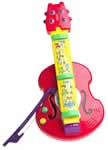 |
The 2-in-1 Bach to Rock Guitar by Fisher-Price requires few steps to work and produces music, making it very engaging. |
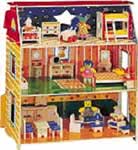 |
This dollhouse evokes dramatic play and imagination. |
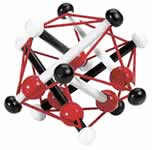 |
Manhattan Toy Company’s Skwish Contrast, a flexible toy made up of multiple shapes, has tactile as well as visual appeal. |
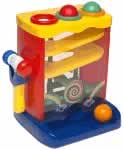 |
Pound-A-Ball by Castle Toy Inc. is an attention getter because of its bold, contrasting colors and intricate parts. |
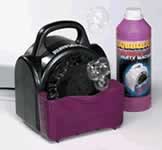 |
Switch activated toys such as the Bubble Pro Bubble Machine allow children to control their environment. |
| Learn More: AT Fact Sheets | ||||
Adapted Toys |
Viewing |
|||
Aids for Low Vision |
||||
Aids for Daily Living |
||||
Assistive listening devices |
||||
Augmentative and Alternative Communication (AAC) |
||||
Computer Access |
||||
Seating, Position and Mobility |
||||
Switches and Environmental Control Units |
||||
Delaware Assistive Technology Initiative
Center for Applied Science & Engineering
University of Delaware/Alfred I. duPont Hospital for Children
PO Box 269, 1600 Rockland Road
Wilmington, DE 19899-0269
1(800) 870-DATI or (302) 651-6790
TDD: (302) 651-6794
FAX: (302) 651-6793
dati-ud@udel.edu
www.dati.org
